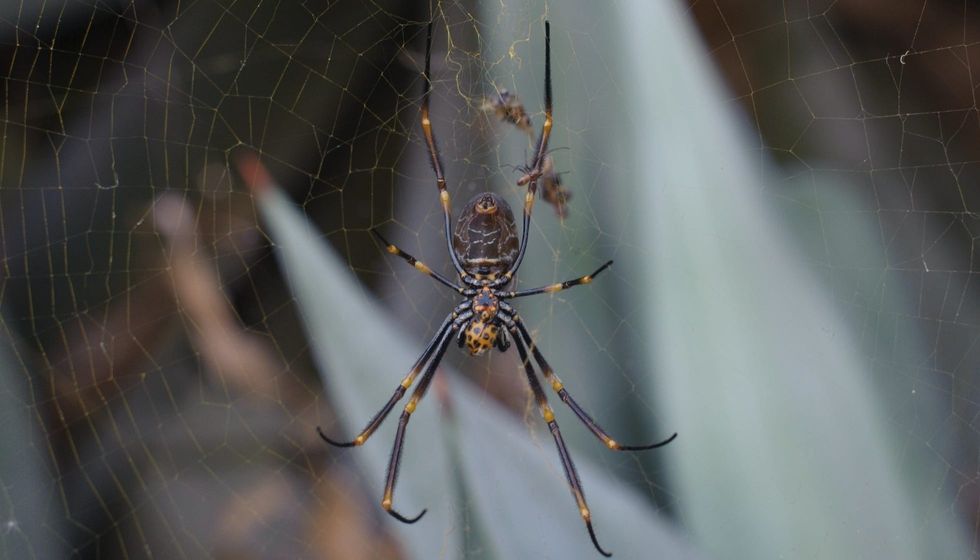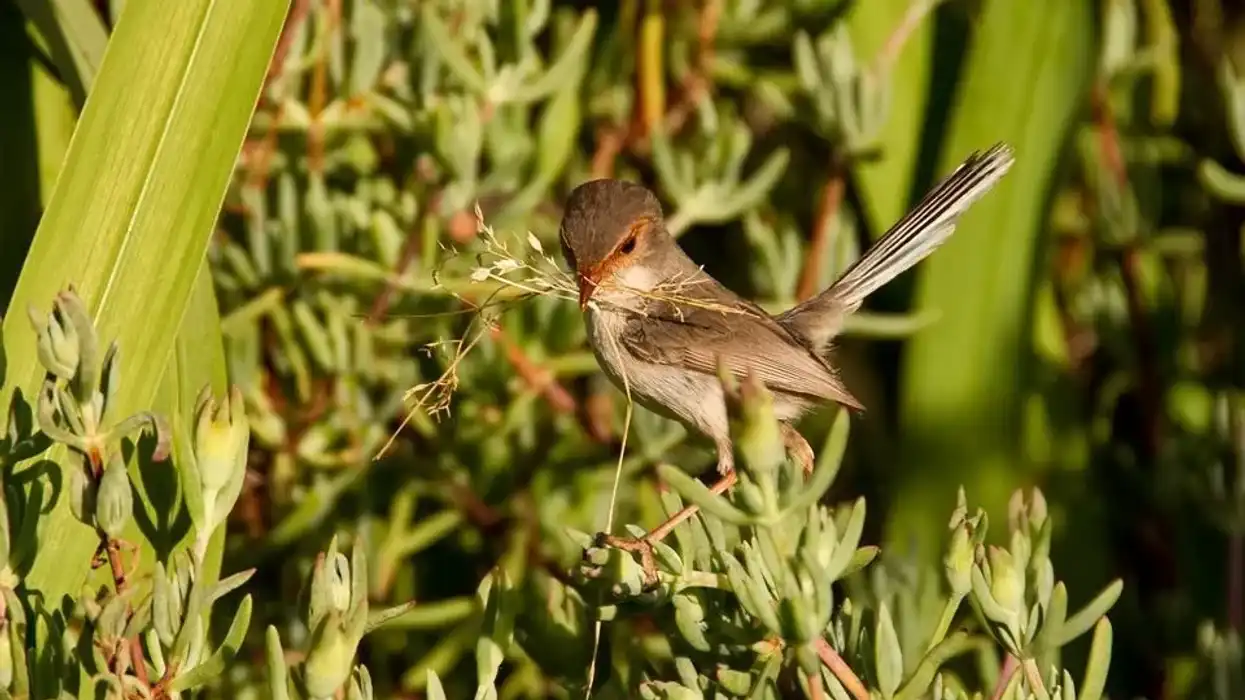The golden orb weaver, a beautiful species that belongs to the family of Araneomorph spiders, is found in different continents such as Asia, Australia, Africa, and America, and recently the species has also been found in New Zealand.
The scientific name of this species is Nephila and they are also known as giant wood spiders and golden silk orb weavers.
They are also known as banana spiders in the United States and are the biggest species of spiders in the country.
The term Nephila has been derived from the ancient Greek word 'neinphilos' which is a combination of two words, 'nein' and 'philos', and the meanings are 'to spin' and 'love' respectively. Therefore, the meaning of Nephila is 'the one who likes to spin' or 'fond of spinning'.
These spiders are either reddish-yellow or greenish-yellow. Unlike other anthropods, a female golden spider is generally larger than a male.
Males are 0.78-1 in (2-2.5 cm) while a female golden spider is 1.5-2 in (4.8-5.1 cm) long.
Also, the average weight of a male spider is 0.0015-0.0022 lbs (0.7-1 gm) while females weigh around 0.0066-0.0088 lbs (3-4 gm). People primarily use the term golden before their name as these spiders make their webs using yellow spider silks which also make them more unique.
Keep on reading to learn more interesting facts about the golden orb weaver. If you want to know more exciting information about different animals, check out Africanized bees and Christmas beetle facts too.
Golden Orb Weaver Interesting Facts
What type of animal is a golden orb weaver?
A golden orb weaver, also known as Nephila scientifically is a spider. They are carnivores and they prey on smaller insects such as beetles and flies.
Some are great predators and even prey on bats and small birds by using their sticky spiral skills. Orb-weaver spiders are also known as banana spiders, giant wood spiders, and golden silk orb weavers.
What class of animal does a golden orb weaver belong to?
The golden spider belongs to the Arachnida class, the family of Araneidae and Nephila genus. The orb-weaving spider is best known for its weaving skills.
How many golden orb weavers are there in the world?
There is no exact population of golden orb weavers as of now but this species is found throughout the world except in the Arctic and Antarctica region. Also, a recent study reveals that there are more than 180 species of the orb-weaver spider alone in the North American continent.
Where does a golden orb weaver live?
Primarily, the golden silk orb-weaver is found in warmer regions and can easily be spotted throughout the world except for Antarctica and the Arctic. The orb weaver is quite common in Australia, Asia, North America, and African countries. Recently, this species was also spotted in New Zealand.
What is a golden orb weaver's habitat?
These orb-weaving spiders generally look for areas with dense vegetation and are found in forests, woodland, and coastal dunes. Wet and urban environments also serve as a golden orb weaver habitat.
Who do golden orb weavers live with?
Unlike other species of spiders, these orb-weavers are usually solitary and live alone. These spiders socialize only during their mating period.
How long does a golden orb weaver live?
The golden orb-weaver spider's lifespan is around 11 to 12 months.
How do they reproduce?
As we know the size of a female golden orb spider is large compared to a male golden orb spider. Also, there are several advantages for small male orb-weavers as they are very quick and can easily catch a female. Unlike other insects and animals, male orb-weavers are quite threatened as their female partner can attack and kill them.
Males usually vibrate their abdomen to attract a female golden orb spider and once they are matured, they leave their web. Also, several males compete with each other in an attempt to court a female spider.
Once they mate, female spiders lay eggs near their web to protect them from predators. To avoid parasites, female spiders lay eggs in small holes in the ground and a female spider lays around 300 to 3000 eggs at a time.
What is their conservation status?
The conservation status of golden spiders is Not Evaluated by the IUCN at the moment as these spiders are generally found throughout the world. A recent study has revealed that more than 180 species of orb weavers have been found in the North American continent.
Also, a few decades back this species of web spider was not native to New Zealand but now a small population of these spiders has been found.
Golden Orb Weaver Fun Facts
What do golden orb weavers look like?
One of the most beautiful species of spiders, the golden orb weaver spider is best known for making an attractive yellow silk web. Females are comparatively larger than male spiders.
They can easily be found in greenish to reddish yellow color and are also one of the most clever predators. These spiders can easily prey on birds and bats which are larger.
How cute are they?
These orb-weaving spiders are best known for making beautiful webs. They use yellow silk to make a web that looks very bright during the daytime. Also as the name suggests, these spiders are bright yellow and also have banded legs that are quite fascinating.
How do they communicate?
Like other species of spiders, a golden orb-weaving spider uses vibrations as a mode of communication. Just like when male spiders vibrate their abdomen to get the attention of a female spider, the same technique is used to repel and warn their predators.
It is also said that orb-weaving spiders mimic the vibrations of other insects to catch their prey like small birds, moths, and other insects.
How big is a golden orb weaver?
Female orb-weaving spiders are generally bigger than male spiders and females generally weigh around 0.0066-0.0088 lbs (3-4 gm) and are 1.5-2 in (4.8-5.1 cm) long. These spiders are twice the size of brown recluse spiders, which are also known as fiddle-back spiders.
Also, these golden spiders are four times larger than black widow spiders which are commonly found on the North American continent. Some golden large spiders are reported to be more than 5 in (12.7 cm) long in a few Southeast Asian countries.
How fast can golden orb weavers move?
The exact speed of golden orb weavers is not known at the moment but the smaller males are said to be quite active. Also, female large spiders are known for distracting their predators and catching them in the sticky spiral orb webs.
How much does a golden orb weaver weigh?
A female orb weaver is comparatively large while males are smaller. The average weight of a male spider is 0.78-1 in (2-2.5 cm) while females weigh around 1.5-2 in (4.8-5.1 cm).
What are the male and female names of the species?
There is no specific name given to male and female golden orb spiders.
What would you call a baby golden orb weaver?
No such name is given to a baby golden orb weaver. Most baby spiders are called spiderlings.
What do they eat?
These spiders are considered potential predators and primarily prey on flying insects and moths. A golden orb weaver diet consists of beetles, flies, locusts, and wood moths. They often make the web in a way that can easily catch small birds and bats.
Are they harmful?
Generally, these spiders do not like human interaction and are not that aggressive. These bright yellow spiders look quite alluring, however, it is suggested that humans should keep a distance because they can attack or bite when threatened.
Also, their bite can be very painful, causing swelling, and redness on the skin. Some people say that these spiders produce venom which can cause death but this is not true. They bite but their venom is not dangerous to humans.
Would they make a good pet?
The answer can be either yes or no. These spiders are not harmful to humans but there are several reasons why people should not keep golden orb weavers as pets.
Firstly, these spiders hide during the daytime and are active at night. Also, the spiders of this species make larger webs compared to other species of spiders which becomes quite unmanageable at home. They are solitary, do not like human interaction, and can also bite if provoked.
Did you know...
An interesting fact about these spiders is that a few entrepreneurs from the United States collected more than 1 million golden orb weavers and made two golden shawls out of their silk web. They also released those collected spiders into the wild.
These shawls were exhibited at the Victoria and Albert Museum in London, and the American Museum of Natural History.
Their webs are also used to catch fish by fishermen on the coast of the Indo-Pacific Ocean.
Like snakes, these spiders also shed their exoskeleton or skin and the process of shedding is known as Ecdysis. Their new exoskeleton is generally harder and larger compared to the older one and once the mating season arrives, they stop shedding.
Depending on the temperature, these spiders change the positions of their bodies and once the temperature rises above 104 F (40 C), they leave their web and hide in a sheltered environment.
Their webs are quite strong compared to the webs of other spiders. Their webs are known for their complex structure and also serve as a barrier web. These spiders often make their webs so strong that it helps them to catch larger prey such as birds and bats.
According to a scientific study, the Nephila is the oldest surviving species of spiders and 165 million years old remains of this spider have been excavated.
An unknown fact about this species is that golden orb weaver spiders generally prey on larger insects than their size. They also store food items and more than 15 prey items can be found above the hub of the web.
What is the difference between a banana spider vs. golden orb weaver?
The golden orb weaver is known by different names in different countries and the banana spider is one of them. As these spiders resemble the color of a banana and are also found on banana trees, the people of Central and South America use the term banana spiders instead of the golden weaver.
Is a golden orb weaver bites dangerous?
Primarily, these spiders don't bite humans unless they are provoked. A golden orb weaver spider bite is quite painful and can cause redness and pain.
Also, the skin could swell for a few days and cause allergic reactions. It is suggested that when a golden orb weaver bites, a person should consult a doctor and take the required medications.
It is also believed that these spiders can cause death by their venom which is not true. No cases of death by golden orb weaver venom have been reported but it is advised to maintain a distance from these spiders.
Here at Kidadl, we have carefully created lots of interesting family-friendly animal facts for everyone to discover! Learn more about some other arthropods including the puss moth, or bombardier beetle.
You can even occupy yourself at home by drawing one on our golden orb weaver coloring pages.
Thank you to John Robert McPherson for providing the main image used in this article.










